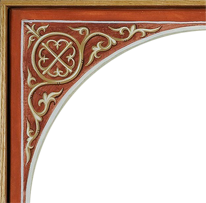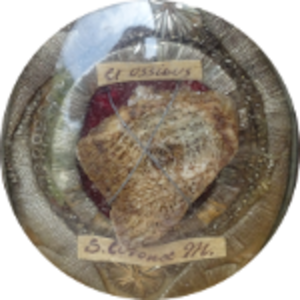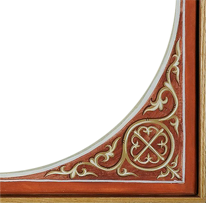
A small relic fragment of the Sudarium of Ovieda, reserved here at All Saints Shrine at Sacred Heart Byzantine Catholic Church, was taken from the linen (shown above). Because our cloth relic was cut directly from an especially blood-saturated area of the Holy Sudarium (identified as the “Corner Stain,” below), our Shrine’s small portion of the Oviedo “face cloth” is rightly given the extraordinarily rare designation as a “First Class Relic” of Christ’s Passion.
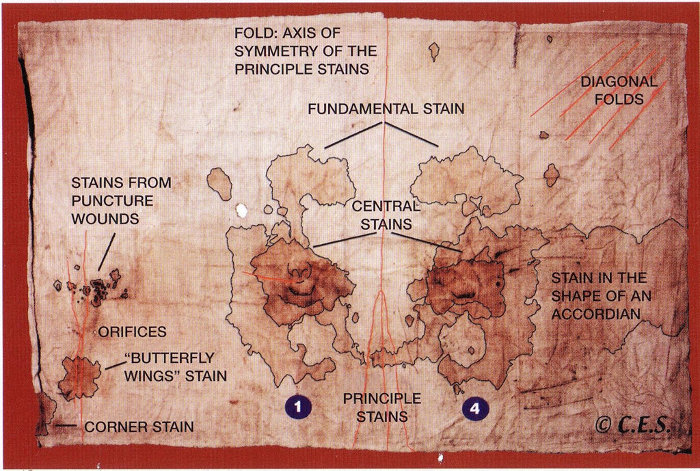
“And so Simon Peter also came, following him, and entered the tomb; and he saw the linen wrappings lying there, and the face-cloth which had been on His head, not lying with the linen wrappings, but rolled up in a place by itself.” -John 20:6-7
The “linen wrappings”—well, that’s the shroud, what has become known as the Shroud of Turin. But what about this “face cloth” that was rolled up in a separate place?
It was Jewish custom at the time of Jesus’ burial to first clean and cover the face, as a sign of respect and compassion for the family. Mourners would then cover the body with fragrant herbs and wrap it in a shroud, or burial cloth. When Jesus rose from the dead, it is believed, he set aside the face cloth before emerging from the tomb.
This small linen napkin, measuring approximately 2¾ feet by 1¾ feet, is called the Sudarium (Latin for “face cloth”). It was preserved from the time of the Crucifixion in a reliquary; however, the two linens were separated—eventually being carried to other countries. The Sudarium made its way to the town of Oviedo, in north-central Spain, where it has been venerated for centuries. In A.D. 840, King Alfonso II of Asturias erected a chapel to protect the Sudarium, which was enshrined in an elaborate reliquary chest called the Arca Santa.
The Sudarium is now housed in a reliquary with a Romanesque metal frontal, and is displayed for the public in Oviedo three times each year: on Good Friday, on the Feast of the Triumph of the Cross (Sept. 14), and during the Octave of the Feast of the Triumph of the Holy Cross.
The Sudarium has assumed importance in recent years for two reasons:
Reason #1. The history of the Sudarium supports the Shroud’s authenticity
Unlike the Shroud (called a “sindon” in New Testament Greek), it has never been missing, so there’s no question regarding its ancient origin.
- Notorious carbon dating of the Shroud of Turin placed its date of origin in the 1300s, meaning that—if this controversial reading were correct—it would be nothing more than a pious forgery.
- On the other hand, the Sudarium—which has been in the possession of the Knights Templar, the Moors, El Cid, saints and bishops—is known to have been in Spain since 631 A.D. Before that it was, according to an account by Antoninus of Piacenza, hidden in a cave near the monastery of St. Mark, not far from Jerusalem. When Persian forces invaded the Byzantine provinces in 614, the oak case in which the Sudarium was kept was spirited out of Palestine through northern Africa by Philip “the Presbyter,” a leader of the Christian community in Palestine. Philip and his precious cargo were welcomed to Alexandria by John the Almoner, bishop of Alexandria at the time. When the Persians pushed on into Egypt, the chest was carried into Spain and entrusted to St. Fulgentius, who sent it on to Seville. The Ark was carried from Toledo north to Monte Sacro in Asturias in 711 A.D., to escape the advancing Moors. It was there that King Alfonso II turned back the Moors and erected a Camara Santa (holy chamber) to shelter the relics. King Alfonso had the ancient oak chest plated with silver with the inscription “The Sacred Sudarium of Our Lord Jesus Christ.”
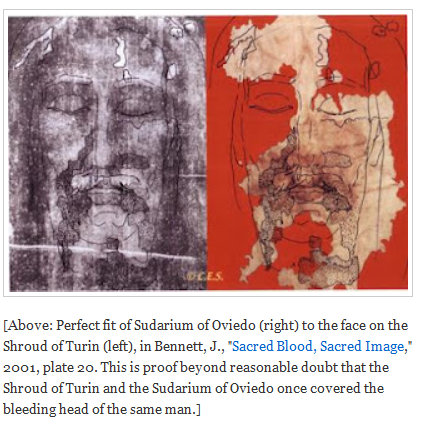
Reason #2. There are similarities between the Shroud and the Sudarium
The Sudarium also helps to authenticate the Shroud of Turin because of notable similarities between the two cloths.
- Of prime importance, the blood and lymph stains on the two cloths match—both are type AB, which was uncommon among medieval Europeans but is a common blood type in the Middle East.
- The material used in the two cloths is identical, although there are differences in the manner of weaving.
- Pollen residues on the Shroud and the Sudarium both provide evidence that the cloths were in the same region of Palestine.
- Stains on the two cloths would also seem to match. Because of the way the Sudarium would have covered the head, there is no clear face print—but there are remarkable correlations between stains on the two cloths. The Sudarium would have been wrapped over the head of Christ while his relatives waited for permission to remove the body; and so the stains show that the body was held in a vertical position with the head dropping back. At the back of the head, the cloth shows blood from deep puncture wounds, similar to the wounds on the Shroud of Turin, which may have been made by the crown of thorns.
- A second, overlaying stain was produced by fluids excreted from the nostrils when the body was lain horizontally. According to the Investigation Team from the Spanish Centre for Sindology, which has been studying the Sudarium since 1989, this second set of stains is composed of one part AB-type blood and six parts oedemal fluid. This fluid proves, according to scientists, that the victim died from asphyxiation—which is the cause of death for people who are crucified.
- Comparing the cloth to the Shroud of Turin, one researcher has identified 70 points of correlation on the front of the Sudarium and 50 on the back. Dr. Alan Whanger, professor emeritus from Duke University, used a Polarized Image Overlay Technique to demonstrate correlations between the two cloths.
(Article source: National Catholic Register / April 18, 2019)
